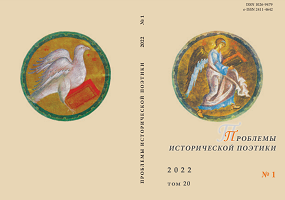«В кораблике моем горит свеча…»: образ реки в «Путевых записках» архиепископа Нила (Н. Ф. Исаковича)
“A Сandle is Burning in my Boat…”: The Image of the River in the “The Travel Notes” of Archbishop Nil (N. F. Isakovich)
Author(s): Sofya V. MelnikovaSubject(s): Christian Theology and Religion, Cultural history, Customs / Folklore, Russian Literature, 19th Century
Published by: Петрозаводский государственный университет
Keywords: Siberian text; geopoetics; Archbishop Nil (Isakovich); river image; church literature; paganism; antiquity; Christianity; travelogue;
Summary/Abstract: The article is devoted to studying the travel prose of the Orthodox clergy in the 19th century as a phenomenon of the Siberian regional literature and one of the classical versions of the “Siberian text.” The boundaries of the “Siberian text” in Russian literature are defined by the characteristics of regional identity, which is reflected in this text and is shaped by the Siberian geographical space. The hypothesis of the importance of the river image - as the most obvious space-time coordinate - in Siberian literature is put forward. The specifics of the representation of this image in the works of the clergy are examined on the example of “Travel Notes” by Nil (Isakovich), Archbishop of Irkutsk (1838–1853). The notes recount missionary journey along the Lena and other rivers in its basin in the summer of 1843. Archbishop Nil constructs the image of the river as a multi-faceted model of human interaction with space - in the context of a Christian worldview, as well as personal and cultural memory. This model is revealed in historical, emotional-psychological, mythopoetic and ontological terms in relation to the categories of chaos and cosmos, border and transition, existential solitude and spiritual transformation. The author’s intention is aimed at overcoming the prehistoric pagan essence of the river in the traveler’s mind through its aestheticization, conceptualization and sacralization as a space of meeting with the Creator. This correlates with the genre strategy of the Christian pilgrimage. The image of the river recreates a dynamic image of all of Siberia - ancient, steeped in primeval chaos, pagan and mythological in its essence, but open to Christian transfiguration and rebirth. The significance of Archbishop Nil’s travel notes, and clergy travelogues in general, in the history of Russian literature is determined by the fact that the Siberian space is reflected in their writings in its spiritual dimension. This approach, in turn, makes it possible to present the process of Siberian exploration in its ontological and axiological essence - as an incorporation into the Russian national consciousness, Christian in its basis.
Journal: Проблемы исторической поэтики
- Issue Year: 20/2022
- Issue No: 1
- Page Range: 110-133
- Page Count: 24
- Language: Russian

